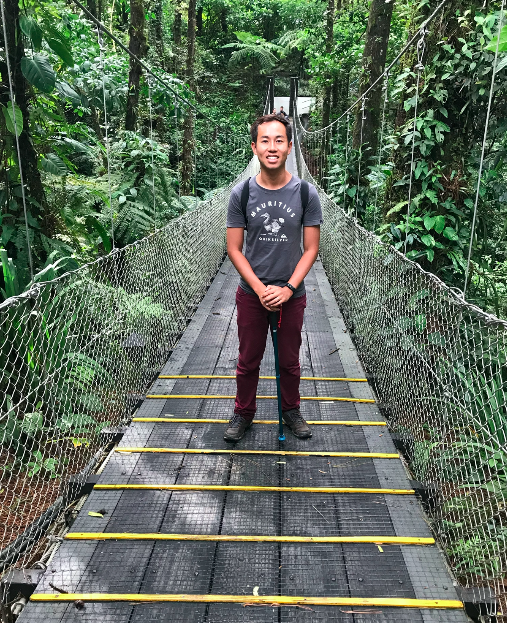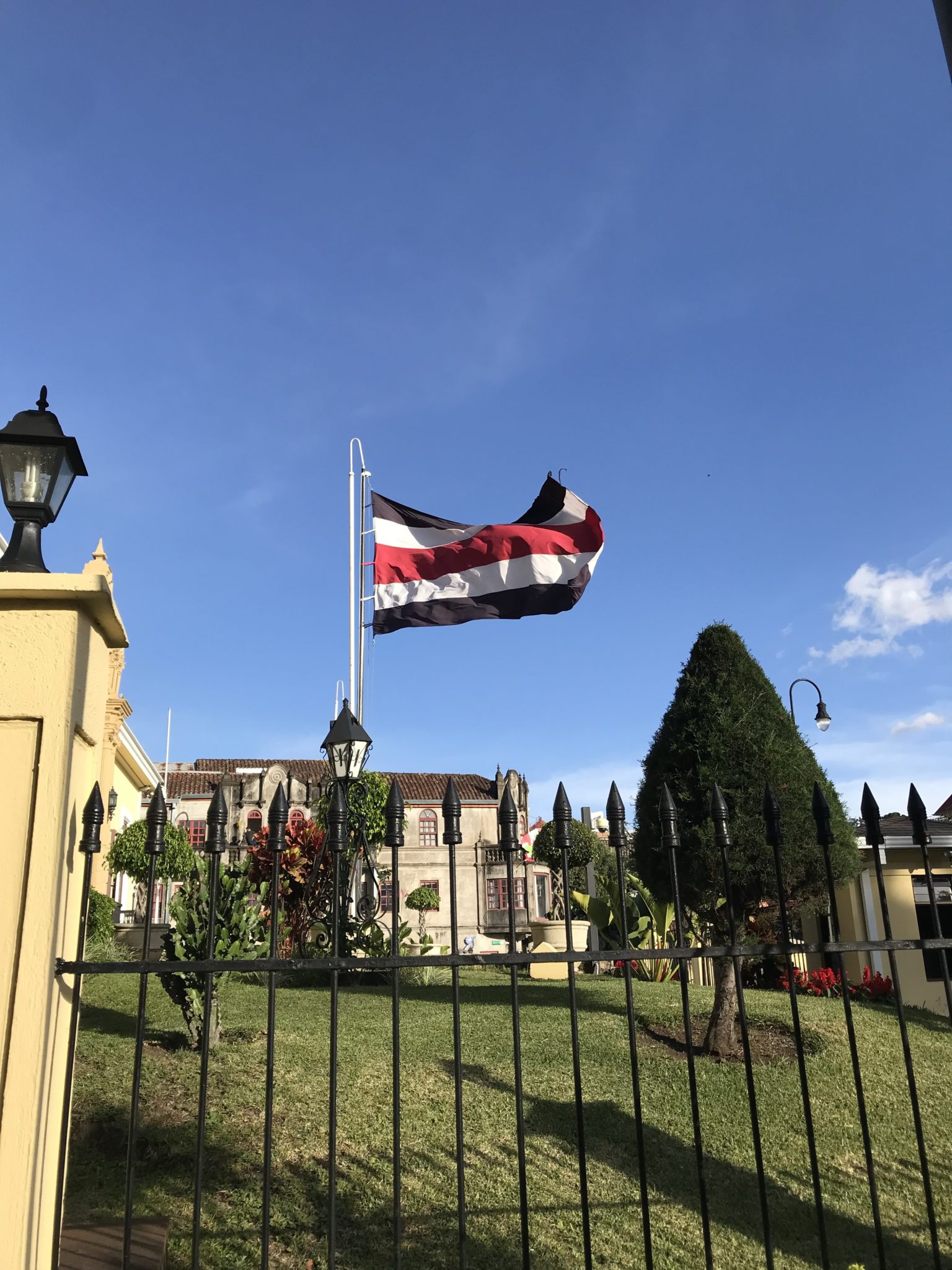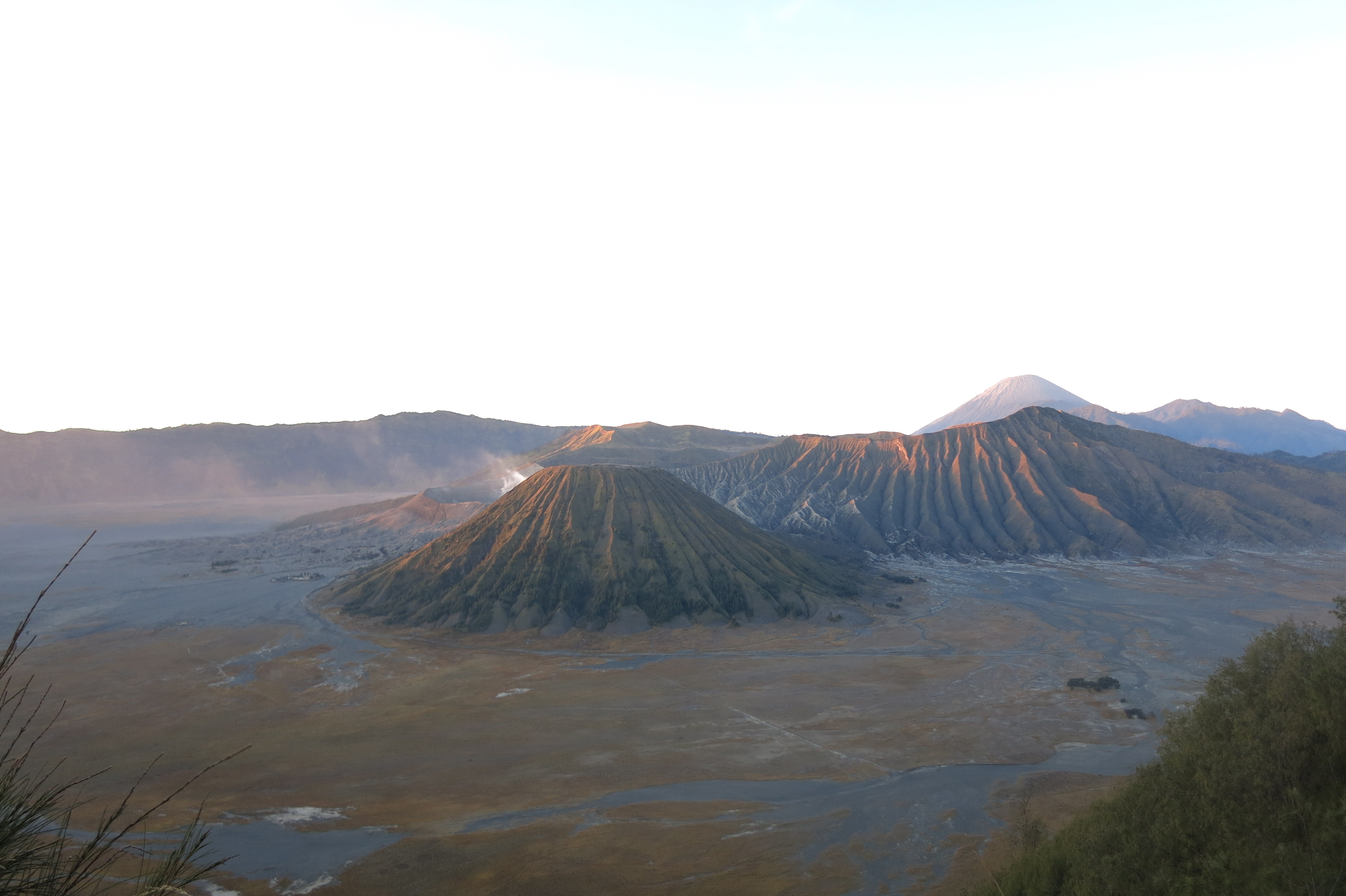
Whether you approach from the west or from the east, the drive into the Arenal area is spectacular. Coming from Tilarán in the west, the road hugs the northern bank of Laguna de Arenal. The lake and forest vistas are riveting. On either side lovely inns, hip coffeehouses and eccentric galleries appear like pictures in a pop-up book. Arenal is actually Costa Rica’s youngest and most active volcano.

Our first stop of the day was hiking through the rainforest of the national park, which brings us near to the volcano but not to the summit. The rainforest is teeming with wildlife and has many trees which have been growing for hundreds of years.

This is such a huge leaf and it can actually shelter a person from the rain.

Some of the trees have huge branches and vines that are strong enough to support a human’s weight. We did a mini Tarzan swing on this vine.

Another interesting fruit that we saw along the way, which kind of reminds me of Medusa’s hair.

The volcano may be dormant, but plenty of adventure still awaits you here. There are trails to hike, waterfalls to rappel down, and sloths to spot. No matter what your preferred method of exploring – hiking, biking, horseback riding, ziplining – you can do it here. And when your body says it’s had enough, you can ease into a volcano-heated pool to soak your aches away.

Following the lava trail, we learnt more about the history of the eruption in 1968. Prior to Arenal’s massive eruption of 1968, it had been inactive for some 450 years. It also entered into a resting phrase during 1973 and the early 1980s. Due to the less developed technology in the past, scientists were unable to predict the exact eruption of Mount Arenal, so many lives were lost. This hike was only 1.2km in distance, but the trail took us to many rocky areas, with spectacular vistas. One of it is the green lake below.

Arenal Volcano’s last big eruption was in 1968, but you can still see the hardened lava flows the eruption left behind. The volcano is none the less still active, so hikers are not allowed to get too close, but if the day is clear, you will be able to see some smoke coming from the crater. However, luck was not on our side on that day.

The black rocks are a stark reminder of the past eruption event, where the lava flowed down the slopes of the mountain and destroyed several villages, killing many people along the way. Today the lava has hardened into black rocks and new vegetation has sprouted around the area.

Standing on the huge lava rock overlooking the national park.

The area is not just a tourist attraction, some locals still continue to live in the surrounding area. To make ends meet, they rear cows, ox and also plant some crops like pineapples on the slopes.

Another popular activity around the area is horseback riding, where you can explore the national park area instead of spending time to walk around.

After completing our intermediate hike and on our way back to the rest area, our guide spotted a sloth hiding among one of the trees. Through his telescope, we saw this sloth hanging in a relaxed manner, with all its fur wet so it was probably letting it dry.

Lunch was a simple affair of rice, some pieces of chicken and salad by the side. It was prepared by the family of the park ranger who cooked just enough for tour group to eat.
The best way to get close to the Arenal volcano, enjoy a jungle walk and visit the hot water river is to go to the Arenal Observatory. Here, there is a private viewing platform as part of the hotel grounds.

Besides looking at the elusive Arenal volcano, you can also admire some hummingbirds. The resort has specially put up some fruits like watermelon and papaya to entice the hummingbirds to come here to feed. Here, you can have a close-up view of the hummingbirds which flap their wings vigorously and also feed at the same time to maintain their balance in the air.

Through our guide’s telescope, we managed to see a close-up of a hummingbird and its colourful features.

Since the resort directly overlooks the volcano as it is within the national park, there are also some hiking trails to see waterfalls. For non-visitors, they have to pay an entrance fee to make use of the hiking trails.

Another segment of the resort is the museum, which talks about the history of the volcano eruption. It also shows various aerial views of both Arenal and Cerro Chato volcanoes, the latter with a crater lake at the top. It can be an educational visit for both adults and children alike, as they learn how to identify the different types of volcanoes and to understand how a volcano eruption occurs.

Outside the resort, we were introduced to a eucalyptus tree with its colourful bark. Eucalyptus trees originate from the land down under, where koalas and kangaroos are home. It has long been introduced to other countries and is famous for its oily leaves and the ability to grow fast. The most distinctive feature of the Eucalyptus deglupta is its multi-hued bark. The rainbow eucalyptus sheds its bark several times per year and reveals a bright green inner bark. This then darkens and matures to give blue, purple, orange and then maroon tones, as seen in the picture below. It can grow to heights of over 80m tall!

In the afternoon, it started to pour again as we were hiking to the waterfall. Two of the guys in our group went for a swim in the plunge pool and it was icy cold. With our ponchos on, we were not so drenched but did not want to go through the hassle of taking off and putting on our clothes, so we gave the chance to swim at the waterfall a miss.

After visiting the waterfall, we went to Danta bridge, which is a suspension bridge across the river and has a length of 55 metres.

When we reached the viewpoint, we tried our best to get another capture of the volcano, but still it was shrouded by clouds.

At the end of a long day, this was the best shot of the Arenal volcano that we could capture. We could not get the perfect cone as the upper one-third part was still covered by the clouds.

To end off a tiring day, our tour brought us to the thermal springs of Arenal. There are a wealth of hot springs in the area surrounding the Arenal Volcano. These springs originate in a geothermally heated underground river. Local hotels tap into this source and bring the water to the surface, creating mineral-rich hot springs for their guests to enjoy. There are various hot spring resorts ranging from basic to luxurious ones.

We relax in its soothing warm water at Termo Arenal Hot Springs for about an hour, enjoy a volcanic mud facial and a complimentary cocktail. Lastly, we were driven back to our hotel. The more popular hot spring resorts include Baldi and Tabacon, but they charge exorbitant entrance fees.

For those looking to learn Spanish, this is a beginner’s guide.

